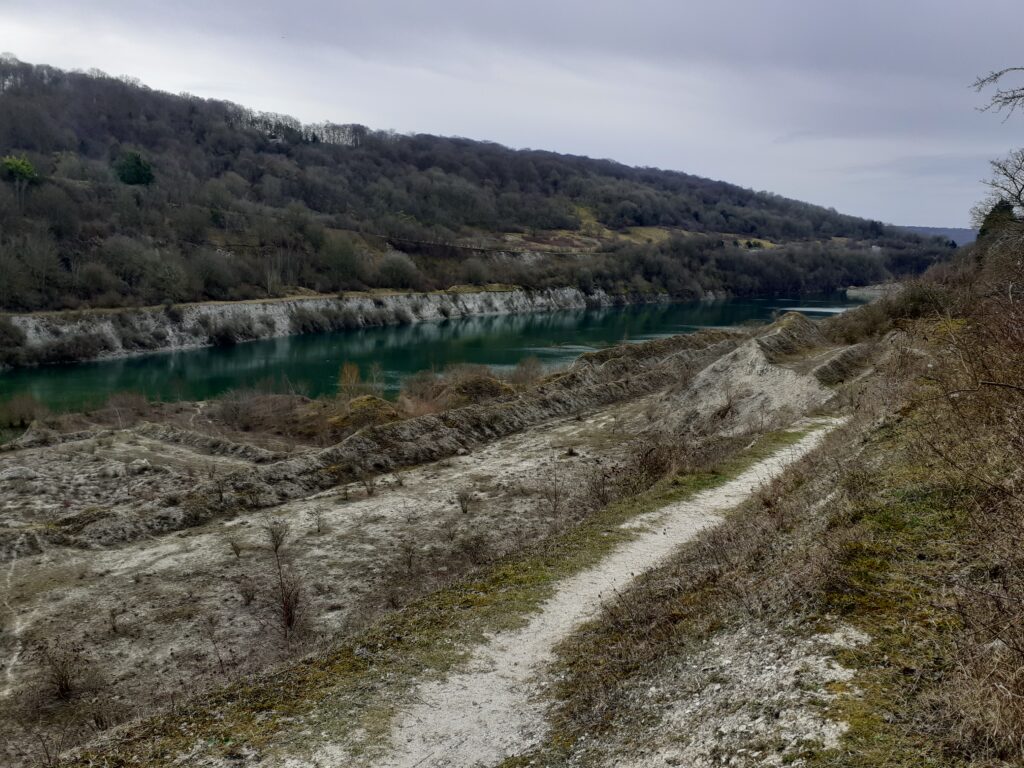I’d already decided I was going to walk from Princes Risborough to Chinnor but spotting the Chinnor Limekiln on Google Maps turned a mere walk into an explore. The weird thing was that the limekiln seemed to be in the middle of a housing estate and that I really did need to check out. I start by taking a train from Bicester to Princes Risborough and heading out towards Chinnor via the Ridgeway. The morning is frosty and misty so I am denied the usual great views but feel rewarded by the spooky atmosphere.

Usually I turn off the Ridgeway before Chinnor, looping back into Princes Risborough via the Chiltern Way or the Icknield Way. This time I continue on the Ridgeway. I have made two false assumptions: that Chinnor is just around the corner (hahaha) and that the path will not be muddy (hahahahahahahahaha). Look how high I am – water should just drain away right?

I found myself trapped on the Ridgeway above Chinnor between the sites of former chalk quarries with ominous Keep Out signs. Looking mournfully down through the chain link fence I can see people walking dogs and having fun in the landscaped and reclaimed quarry site below but can’t see any way to join them. Sighing I contemplate more mud and continue on the Ridgeway. Suddenly, to the other side of the path I see a spot where the fence has been entirely removed. Ignoring the many Keep Out and Private Land signs, I follow what is a pretty well-worn footpath and indulge in a favourite hobby of minor trespass. It’s worth it, as I am met with a breath-taking sight, a staggering view, a lost world. The scale is hard to express and photos don’t so it justice but in front of me is a flooded former chalk quarry. The colours are incredible even on an overcast day; the water looks aquamarine. If the odd mammoth or other extinct exotic creature appeared in this hidden world I would not have been surprised.

Back on the Ridgeway the next 30 minutes is characterised by incessant mud and more Keep Out signs. Finally I find a path to my right taking me to Chinnor and the other chalk pits below the path. These pits have been landscaped and the site turned into recreation grounds called ‘Old Kiln Lakes’. The information boards give some history of the site: the chalk quarry was first established in 1908 and the chalk processed using up to five beehive kilns. By 1920 a large cement factory had been established in Chinnor, serviced by rail by what is now the Princes Risborough and Chinnor Railway. The factory closed in 1999, the site was cleared in 2009 and a housing estate built. The former chalk extraction pits have been flooded and are now wildlife habitats. After wading through more mud (brilliant white chalky mud this time, for a change) I find myself in the open space that I had been looking down on longingly an hour or so ago. A good spot to drink some coffee and contemplate.

Although I was happy to have made it, I was already dreading walking back through all that mud. First though, I had a limekiln to find – that’s why I’d come all of this way after all. Passing by the (closed) station for the heritage railway I walked into the housing estate built on the site of the cement works. This very modern estate seemed an unlikely place for preserved industrial heritage but Google Maps had not lied. Walking down Kiln Lane and down a pedestrian alley, there is it. Surrounded on all sides by houses and nearly as tall as the houses themselves was the last remaining beehive kiln from the Chinnor cement works.

According to the information board this kiln is Grade II listed and was built when the Chinnor Lime Works was established by William Benton in 1908. The small factory produced lime for agriculture and building but then expanded to cement in later years. By 1923 the five beehive kilns on the site were redundant due to improved technology. The others have been demolished but this one was restored from its former derelict state in 2007.
I would very much like to have a beehive limekiln in my front garden and I hope the residents of Kiln Lane appreciate theirs. I would also very much like to be home right now rather than having to walk back through all that mud but don’t really have much choice. I realise afterwards there was a bus I could have taken but I wouldn’t have felt so virtuous. I also wouldn’t have got to enjoy the views I got on the Icknield Way on the way back.

